Pioneer DEH-4400BT User Manual [en, ru, de, es, fr, it]

CD RDS RECEIVER
AUTORADIO CD RDS SINTOLETTORE CD RDS
REPRODUCTOR DE CD CON RECEPTOR RDS CD RDS-EMPFÄNGER
CD RDS-ONTVANGER
CD RDS ПРИЕМНИК
DEH-4400BT
Installation Manual
Manuel d’installation Manuale d’installazione Manual de instalación Installationsanleitung Installatiehandleiding
Руководство по установке
Русский Nederlands Deutsch Español Italiano Français English
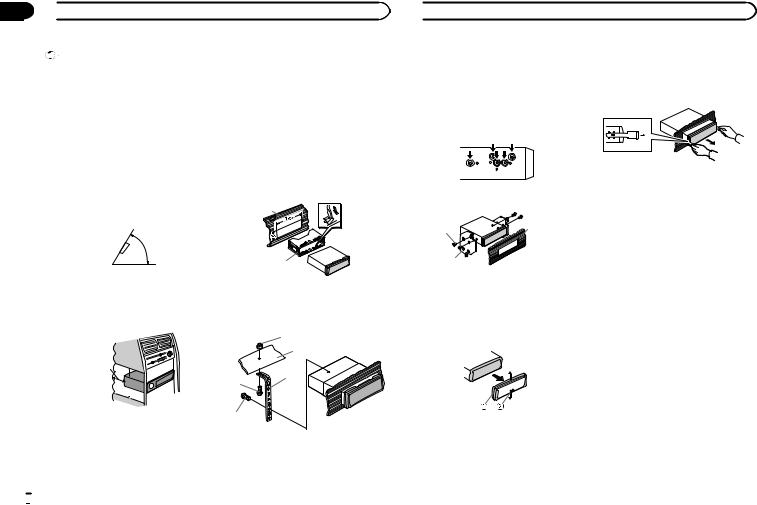
Section
01  Installation
Installation
Important |
|
Use commercially available parts when instal- |
|
! Check all connections and systems before |
ling. |
||
final installation. |
|
DIN Front-mount |
|
! Do not use unauthorized parts as this may |
|||
cause malfunctions. |
1 Insert the mounting sleeve into the dash- |
||
! Consult your dealer if installation requires |
|||
board. |
|||
drilling of holes or other modifications to the |
|||
For installation in shallow spaces, use the sup- |
|||
vehicle. |
|
||
|
plied mounting sleeve. If there is enough space, |
||
! Do not install this unit where: |
|||
use the mounting sleeve that came with the ve- |
|||
— it may interfere with operation of the vehicle. |
|||
hicle. |
|||
— it may cause injury to a passenger as a result |
|||
|
|||
of a sudden stop. |
2 Secure the mounting sleeve by using a |
||
! The semiconductor laser will be damaged if |
|||
screwdriver to bend the metal tabs (90°) into |
|||
it overheats. Install this unit away from hot |
|||
place. |
|||
places such as near the heater outlet. |
|||
|
|||
! Optimum performance is obtained when the |
1 |
||
unit is installed at an angle of less than 60°. |
|||
|
|||
|
60° |
|
|
|
|
2 |
|
! When installing, to ensure proper heat dis- |
|
||
persal when using this unit, make sure you |
1 Dashboard |
||
leave ample space behind the rear panel and |
2 Mounting sleeve |
||
wrap any loose cables so they are not block- |
|
||
ing the vents. |
|
3 Install the unit as illustrated. |
|
|
|
1 |
|
|
|
2 |
|
Leave ample |
5 cm |
|
|
space |
3 |
||
|
|||
|
|
||
|
|
4 |
|
5 cm
5cm
DIN front/rear mount
This unit can be properly installed using either front-mount or rear-mount installation.
 2
2 En
En
5
1Nut
2Firewall or metal support
3Metal strap
4Screw
5Screw (M4 × 8)
 Installation
Installation
# Make sure that the unit is installed securely in place. An unstable installation may cause skipping or other malfunctions.
DIN Rear-mount
1 Determine the appropriate position where the holes on the bracket and the side of the unit match.
2 Tighten two screws on each side.
1 |
3 |
|
2
1Tapping screw (5 mm × 8 mm)
2Mounting bracket
3Dashboard or console
Removing the unit
1 Remove the trim ring.
1Trim ring
2Notched tab
!Releasing the front panel allows easier access to the trim ring.
!When reattaching the trim ring, point the side with the notched tab down.
2Insert the supplied extraction keys into both sides of the unit until they click into place.
3Pull the unit out of the dashboard.
Removing and re-attaching the front panel
You can remove the front panel to protect your unit from theft.
Press the detach button and push the front panel upward and pull it toward you.
For details, refer to operation manual.

 Connections
Connections
 Important
Important
!When installing this unit in a vehicle without an ACC (accessory) position on the ignition switch, failure to connect the red cable to the terminal that detects operation of the ignition key may result in battery drain.
|
F |
ON |
|
|
F |
|
|
|
O |
|
S |
|
|
|
T |
|
|
TR |
A |
|
|
|
|
ACC position |
No ACC position |
||
!Use of this unit in conditions other than the following could result in fire or malfunction.
—Vehicles with a 12-volt battery and negative grounding.
—Speakers with 50 W (output value) and 4 ohm to 8 ohm (impedance value).
!To prevent a short-circuit, overheating or malfunction, be sure to follow the directions below.
—Disconnect the negative terminal of the battery before installation.
—Secure the wiring with cable clamps or adhesive tape. Wrap adhesive tape around wiring that comes into contact with metal parts to protect the wiring.
—Place all cables away from moving parts, such as the shift lever and seat rails.
—Place all cables away from hot places, such as near the heater outlet.
—Do not connect the yellow cable to the battery by passing it through the hole to the engine compartment.
—Cover any disconnected cable connectors with insulating tape.
—Do not shorten any cables.
—Never cut the insulation of the power cable of this unit in order to share the power with other devices. The current capacity of the cable is limited.
—Use a fuse of the rating prescribed.
—Never wire the negative speaker cable directly to ground.
—Never band together negative cables of multiple speakers.
!When this unit is on, control signals are sent through the blue/white cable. Connect this cable to the system remote control of an external power amp or the vehicle’s auto-anten- na relay control terminal (max. 300 mA
12 V DC). If the vehicle is equipped with a glass antenna, connect it to the antenna booster power supply terminal.
!Never connect the blue/white cable to the power terminal of an external power amp. Also, never connect it to the power terminal of the auto antenna. Doing so may result in battery drain or a malfunction.
!The black cable is ground. Ground cables for this unit and other equipment (especially, high-current products such as power amps) must be wired separately. If they are not, an accidental detachment may result in a fire or malfunction.
This unit
3
1 2  4 5
4 5
6 |
7 |
8 |
1Power cord input
2Microphone input
3Microphone
4Rear output or subwoofer output
5Front output
6Antenna input
7Fuse (10 A)
8Wired remote input
 Connections
Connections
Hard-wired remote control adaptor can be connected (sold separately).
Power cord
|
3 |
4 |
|
2 |
5 |
6 |
1 |
|
|||
|
3 |
4 |
|
7 |
5 |
6 |
|
|
8 |
|
|
|
|
a |
|
|
9 |
b |
|
|
d |
|
|
|
|
|
c |
1To power cord input
2Depending on the kind of vehicle, the function of 3 and 5 may be different. In this case, be sure to connect 4 to 5 and 6 to
3.
3Yellow
Back-up (or accessory)
4Yellow
Connect to the constant 12 V supply terminal.
5Red
Accessory (or back-up)
6Red
Connect to terminal controlled by ignition switch (12 V DC).
7Connect leads of the same color to each other.
8Black (chassis ground)
9Blue/white
The pin position of the ISO connector will differ depending on the type of vehicle. Connect 9 and b when Pin 5 is an antenna control
type. In another type of vehicle, never connect 9 and b.
aBlue/white
Connect to system control terminal of the power amp (max. 300 mA 12 V DC).
bBlue/white
Connect to auto-antenna relay control terminal (max. 300 mA 12 V DC).
cSpeaker leads White: Front left +
White/black: Front left * Gray: Front right + Gray/black: Front right *
Green: Rear left + or subwoofer + Green/black: Rear left * or subwoofer * Violet: Rear right + or subwoofer + Violet/black: Rear right * or subwoofer *
dISO connector
In some vehicles, the ISO connector may be divided into two. In this case, be sure to connect to both connectors.
Notes
!Change the initial setting of this unit (refer to the Operation Manual). The subwoofer output of this unit is monaural.
!When using a subwoofer of 70 W (2 Ω), be sure to connect the subwoofer to the violet and violet/black leads of this unit. Do not connect anything to the green and green/ black leads.
Section
02
English
En  3
3
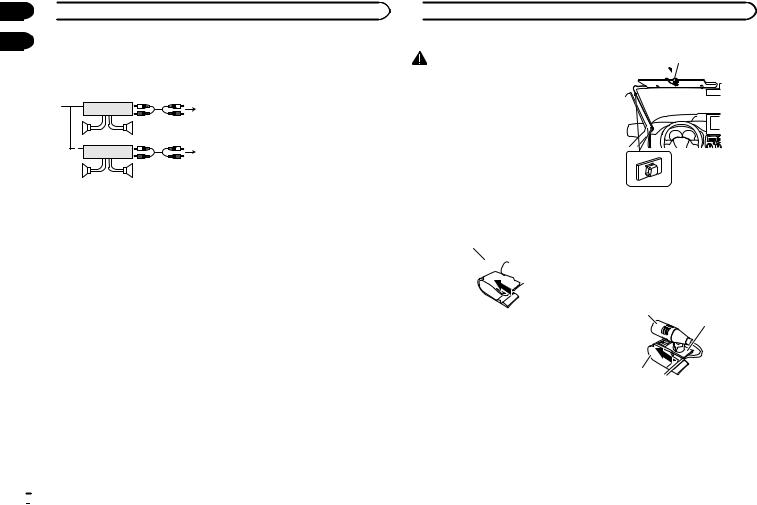
Section
02  Connections
Connections
03
Power amp (sold separately)
Perform these connections when using the optional amplifier.
|
1 |
|
3 |
|
|
|
|
|
|
|
|
2 |
|
|
|
|
|
|
4 |
|
|
|
||
|
5 |
|
5 |
|
|
|
|
|
|
|
|
|
3 |
|
|
1 |
2 |
|
|
|
|
|
6 |
|
|
|
|
|
|
|
|
|
||
|
7 |
|
7 |
|
|
|
|
|
|
1 |
System remote control |
|
||
|
Connect to Blue/white cable. |
|
||
2 |
Power amp (sold separately) |
|
||
3 |
Connect with RCA cables (sold separately) |
|||
4 |
To Front output |
|
|
|
5 |
Front speaker |
|
|
|
6 |
To Rear output or subwoofer output |
|
||
7 |
Rear speaker or subwoofer |
|
||
 Installing the microphone
Installing the microphone
CAUTION |
1 |
|
It is extremely dangerous to allow the microphone lead to become wound around the steering column or shift lever. Be sure to install the unit in such a way that it will not obstruct driving.
Note
Install the microphone in a position and orientation that will enable it to pick up the voice of the person operating the system.
When installing the microphone on the sun visor
1 Install the microphone on the microphone clip.
 2
2
1Microphone clip
2Clamp
1
2



1Microphone
2Microphone clip
2 Install the microphone clip on the sun visor.
With the sun visor up, install the microphone clip. (Lowering the sun visor reduces the voice recognition rate.)
When installing the microphone on the steering column
1 Install the microphone on the microphone clip.
1
2
3 
4
1Microphone
2Microphone base
3Microphone clip
4Fit the microphone lead into the groove.
 4
4 En
En
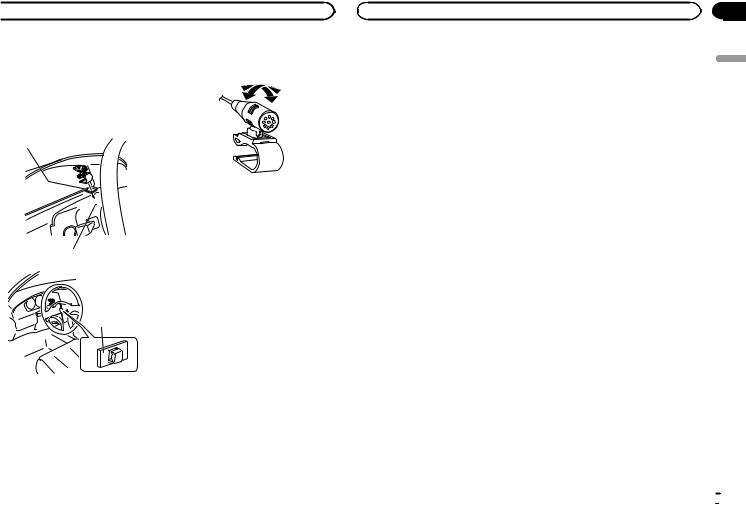
 Installing the microphone
Installing the microphone
# Microphone can be installed without using mi- |
Adjusting the microphone |
crophone clip. In this case, detach the microphone |
angle |
base from the microphone clip. To detach the micro- |
|
phone base from the microphone clip, slide the mi- |
|
crophone base. |
|
2 Install the microphone clip on the steering column.
1
The microphone angle can be adjusted.
2
3
1Double-sided tape
2Install the microphone clip on the rear side of the steering column.
3Clamp
Section
03
English
En  5
5

Section
01  Installation
Installation
Important |
|
Montage avant/arrière DIN |
|
! Vérifiez toutes les connexions et tous les sys- |
Cet appareil peut être installé correctement soit |
||
tèmes avant l’installation finale. |
|||
en montage frontal ou en montage arrière. |
|||
! N’utilisez pas de pièces non autorisées car il |
|||
Utilisez des pièces disponibles dans le |
|||
peut en résulter des dysfonctionnements. |
|||
commerce lors de l’installation. |
|||
! Consultez votre revendeur si l’installation né- |
|||
|
|||
cessite le perçage de trous ou d’autres modi- |
Montage frontal DIN |
||
fications du véhicule. |
|||
|
|||
! N’installez pas cet appareil là où : |
1 Insérez le manchon de montage dans le |
||
— il peut interférer avec l’utilisation du véhicule. |
tableau de bord. |
||
— il peut blesser un passager en cas d’arrêt |
Lors de l’installation de cet appareil dans un es- |
||
soudain du véhicule. |
pace peu profond, utilisez le manchon de mon- |
||
! Le laser à semi-conducteur sera endommagé |
tage fourni. Si l’espace est insuffisant, utilisez le |
||
s’il devient trop chaud. Installez cet appareil |
manchon de montage fourni avec le véhicule. |
||
à l’écart de tous les endroits chauds, par |
|
||
exemple les sorties de chauffage. |
2 Fixez le manchon de montage en utilisant |
||
! Des performances optimales sont obtenues |
un tournevis pour courber les pattes métalli- |
||
quand l’appareil est installé à un angle infé- |
ques (90°) en place. |
||
rieur à 60°. |
|
|
|
|
|
1 |
|
|
60° |
|
|
! Lors de l’installation, pour assurer une dis- |
2 |
||
persion correcte de la chaleur quand cet ap- |
|
||
pareil est utilisé, assurez-vous de laisser un |
1 Tableau de bord |
||
espace important derrière la face arrière et |
|||
enroulez les câbles volants de façon qu’ils ne |
2 Manchon de montage |
||
bloquent pas les orifices d’aération. |
3 Installez l’appareil comme indiqué sur la |
||
|
|
||
|
|
figure. |
|
|
|
1 |
|
Laissez suffisamment |
5 cm |
2 |
|
d’espace |
|||
|
|||
|
5 cm 5cm |
3 |
|
|
|
||
|
|
4 |
|
|
|
5 |
|
 6
6 Fr
Fr
 Installation
Installation
1Écrou
2Pare-feu ou support métallique
3Attache en métal
4Vis
5Vis (M4 × 8)
#Assurez-vous que l’appareil est correctement mis en place. Toute installation instable peut entraîner des sauts ou autres dysfonctionnements.
2 Encoche
!Relâcher la face avant permet d’accéder plus facilement à l’anneau de garniture.
!Quand vous remontez l’anneau de garniture, pointez le côté avec l’encoche vers le bas.
2 Insérez les clés d’extraction fournies dans les deux côtés de l’appareil jusqu’à ce qu’elles s’enclenchent en place.
Montage arrière DIN
1 Déterminez la position appropriée où les trous sur le support et sur le côté de l’appareil se correspondent.
2 Serrez deux vis de chaque côté.
1 |
3 |
|
2
1Vis taraudeuse (5 mm × 8 mm)
2Support de montage
3Tableau de bord ou console
Retrait de l’appareil
1 Retirez l’anneau de garniture.
3 Tirez l’appareil hors du tableau de bord.
Retrait et remontage de la face avant
Vous pouvez retirer la face avant pour protéger l’appareil contre le vol.
Appuyez sur la touche de retrait, puis poussez la face avant vers le haut et tirez-la vers vous.
Pour plus de détails, reportez-vous au mode d’emploi.
1 Anneau de garniture
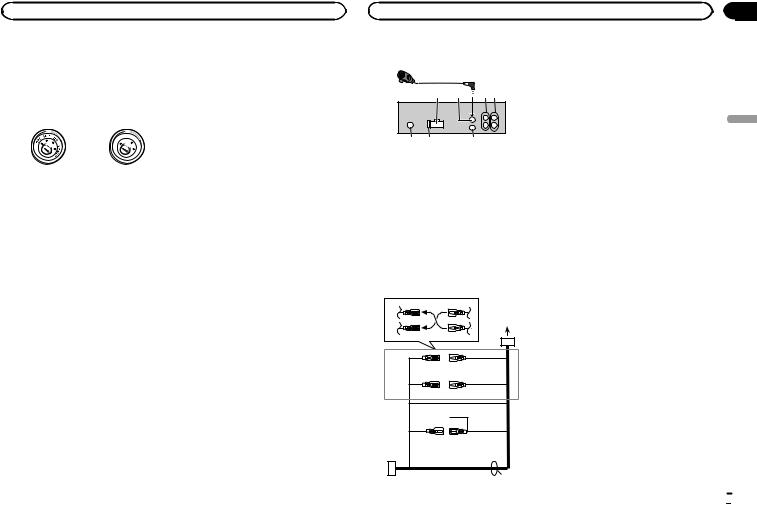
|
|
Section |
Connexions |
Connexions |
02 |
 Important
Important
!Lors de l’installation de cet appareil dans un véhicule sans position ACC (accessoire) sur le contacteur d’allumage, ne pas connecter le câble rouge à la borne qui détecte l’utilisation de la clé de contact peut entraîner le déchargement de la batterie.
|
F |
ON |
|
|
F |
|
|
|
O |
|
S |
|
|
|
T |
|
|
TR |
A |
|
|
|
|
Avec position ACC |
Sans position ACC |
||
!L’utilisation de cet appareil dans des conditions autres que les conditions suivantes pourrait provoquer un incendie ou un mauvais fonctionnement.
—Véhicules avec une batterie 12 volts et mise à la masse du négatif.
—Haut-parleurs avec une puissance de sortie de 50 W et une impédance de 4 ohms à
8 ohms.
!Pour éviter un court-circuit, une surchauffe ou un dysfonctionnement, assurez-vous de respecter les instructions suivantes.
—Déconnectez la borne négative de la batterie avant l’installation.
—Fixez le câblage avec des serre-fils ou de la bande adhésive. Pour protéger le câblage, enroulez dans du ruban adhésif les parties du câblage en contact avec des pièces en métal.
—Placez les câbles à l’écart de toutes les parties mobiles, telles que le levier de vitesse et les rails des sièges.
—Placez les câbles à l’écart de tous les endroits chauds, par exemple les sorties de chauffage.
—Ne reliez pas le câble jaune à la batterie à travers le trou dans le compartiment moteur.
—Recouvrez tous les connecteurs de câbles qui ne sont pas connectés avec du ruban adhésif isolant.
—Ne raccourcissez pas les câbles.
—Ne coupez jamais l’isolation du câble d’alimentation de cet appareil pour partager l’alimentation avec d’autres appareils. La capacité en courant du câble est limitée.
—Utilisez un fusible correspondant aux caractéristiques spécifiées.
—Ne câblez jamais le câble négatif du haut-par- leur directement à la masse.
—Ne réunissez jamais ensemble les câbles négatifs de plusieurs haut-parleurs.
!Lorsque cet appareil est sous tension, les signaux de commande sont transmis via le câble bleu/blanc. Connectez ce câble à la télécommande du système d’un amplificateur de puissance externe ou à la borne de commande du relais de l’antenne motorisée du véhicule (max. 300 mA 12 V CC). Si le véhicule est équipé d’une antenne intégrée à la lunette arrière, connectez-le à la borne d’alimentation de l’amplificateur d’antenne.
!Ne reliez jamais le câble bleu/blanc à la borne d’alimentation d’un amplificateur de puissance externe. De même, ne le reliez pas à la borne d’alimentation de l’antenne motorisée. Dans le cas contraire, il peut en résulter un déchargement de la batterie ou un dysfonctionnement.
!Le câble noir est la masse. Les câbles de terre de cet appareil et d’autres produits (particulièrement les produits avec des courants élevés tels que l’amplificateur de puissance) doivent être câblés séparément. Dans le cas contraire, ils peuvent se détacher accidentellement et provoquer un incendie ou un dysfonctionnement.
Cet appareil
3
1 2  4 5
4 5
6 |
7 |
8 |
1Entrée cordon d’alimentation
2Entrée microphone
3Microphone
4Sortie arrière ou haut-parleur d’extrêmes graves
5Sortie avant
6Entrée antenne
7Fusible (10 A)
8Entrée télécommande câblée
Un adaptateur de télécommande câblée (vendu séparément) peut être connecté.
Cordon d’alimentation
|
3 |
4 |
|
2 |
5 |
6 |
1 |
|
|||
|
3 |
4 |
|
7 |
5 |
6 |
|
|
8 |
|
|
|
|
a |
|
|
9 |
b |
|
|
d |
|
|
|
|
|
c |
1Vers l’entrée cordon d’alimentation
2Selon le type de véhicule, 3 et 5 peuvent avoir une fonction différente. Dans ce cas, assurez-vous de connecter 4 à 5 et 6 à 3.
3Jaune
Alimentation de secours (ou accessoire)
4Jaune
Connectez à la borne d’alimentation 12 V permanente.
5Rouge
Accessoire (ou alimentation de secours)
6Rouge
Connectez à la borne contrôlée par le contact d’allumage (12 V CC).
7Connectez les fils de même couleur ensemble.
8Noir (masse du châssis)
9Bleu/blanc
La position des broches du connecteur ISO est différente selon le type de véhicule. Connectez 9 et b lorsque la broche 5 est de type commande de l’antenne. Dans un type différent de véhicule, ne connectez jamais 9 et b.
aBleu/blanc
Connectez à la prise de commande du système de l’amplificateur de puissance (max. 300 mA 12 V CC).
bBleu/blanc
Connectez à la borne de commande du relais de l’antenne motorisée (max. 300 mA 12 V CC).
cFils du haut-parleur Blanc : Avant gauche +
Blanc/noir : Avant gauche * Gris : Avant droite + Gris/noir : Avant droite *
Vert : Arrière gauche + ou haut-parleur d’extrêmes graves +
Français
Fr  7
7

Section |
|
|
|
|
|
02 |
|
Connexions |
|
|
|
03 |
|
|
|
|
|
|
Vert/noir : Arrière gauche * ou haut-parleur |
3 |
Connectez avec des câbles RCA (vendus sé- |
||
|
d’extrêmes graves * |
|
parément) |
||
|
Violet : Arrière droite + ou haut-parleur d’ex- |
4 |
Vers la sortie avant |
||
|
trêmes graves + |
5 |
Haut-parleur avant |
||
|
Violet/noir : Arrière droite * ou haut-parleur |
6 |
Sortie arrière ou haut-parleur d’extrêmes gra- |
||
|
d’extrêmes graves * |
|
ves |
||
|
d Connecteur ISO |
7 |
Haut-parleur arrière ou haut-parleur d’extrê- |
||
|
Dans certains véhicules, il est possible que |
|
mes graves |
||
|
le connecteur ISO soit divisé en deux. Dans |
|
|
|
|
|
ce cas, assurez-vous de connecter les deux |
|
|
|
|
|
connecteurs. |
|
|
|
|
Remarques
!Changez les réglages initiaux de cet appareil (reportez-vous au mode d’emploi). La sortie haut-parleur d’extrêmes graves de cet appareil est monaurale.
!Lors de l’utilisation d’un haut-parleur d’extrêmes graves de 70 W (2 Ω), assurez-vous de connecter le haut-parleur d’extrêmes graves aux fils violet et violet/noir de cet appareil. Ne connectez aucun périphérique aux fils vert et vert/noir.
Amplificateur de puissance (vendu séparément)
Réalisez ces connexions lors de l’utilisation d’un amplificateur optionnel.
1 |
|
3 |
|
|
|
||
|
2 |
|
|
|
|
4 |
|
|
|||
5 |
|
5 |
|
|
|
|
|
|
|
3 |
|
1 |
2 |
|
|
|
6 |
||
|
|
||
|
|||
7 |
|
7 |
|
|
|
|
1 Télécommande du système Connectez au câble bleu/blanc.
2 Amplificateur de puissance (vendu séparément)
 Installation du microphone
Installation du microphone
PRÉCAUTION |
1 |
|
Il est extrêmement dangereux de laisser le fil du microphone s’enrouler autour de la colonne de direction ou du levier de vitesse. Assurez-vous d’installer cet appareil de telle manière qu’il ne gêne pas la conduite.
Remarque
Installez le microphone dans une position et une orientation qui lui permette de capter la voix de la personne qui utilise le système.
Si vous installez le microphone sur le pare-soleil
1 Installez le microphone sur le clip microphone.
 2
2
1Clip microphone
2Serre-fils
1
2



1Microphone
2Clip microphone
2 Installez le clip microphone sur le paresoleil.
Avec le pare-soleil relevé, installez le clip microphone. (Abaisser le pare-soleil réduit le taux de reconnaissance vocale.)
Si vous installez le microphone sur la colonne de direction
1 Installez le microphone sur le clip microphone.
1
2
3 
4
1Microphone
2Base pour microphone
3Clip microphone
4Insérez le fil du microphone dans la fente.
#Le microphone peut être installé sans le clip microphone. Dans ce cas, détachez la base pour microphone du clip microphone. Pour détacher la base pour microphone du clip microphone, faites-la glisser.
 8
8 Fr
Fr
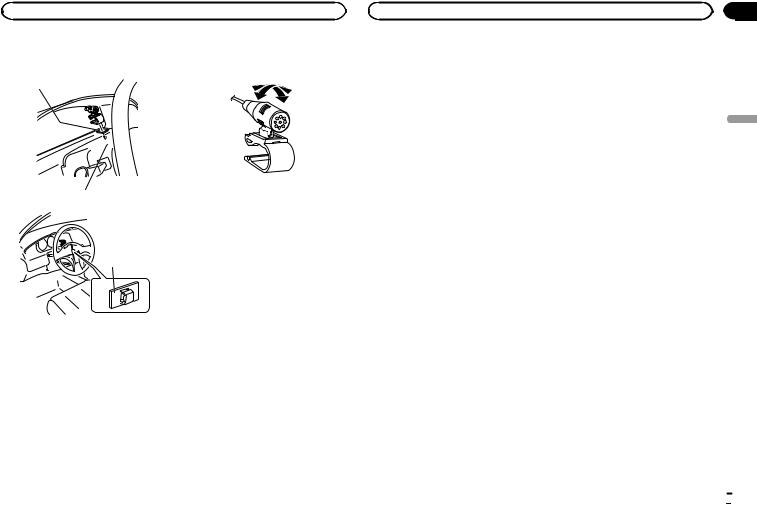
|
Section |
Installation du microphone |
03 |
2 Installez le clip microphone sur la colonne |
Réglage de l’angle du |
de direction. |
microphone |
|
|
1 |
|
|
Français |
L’angle du microphone peut être réglé.
2
3
1Bande double face
2Installez le clip microphone sur la face arrière de la colonne de direction.
3Serre-fils
Fr  9
9
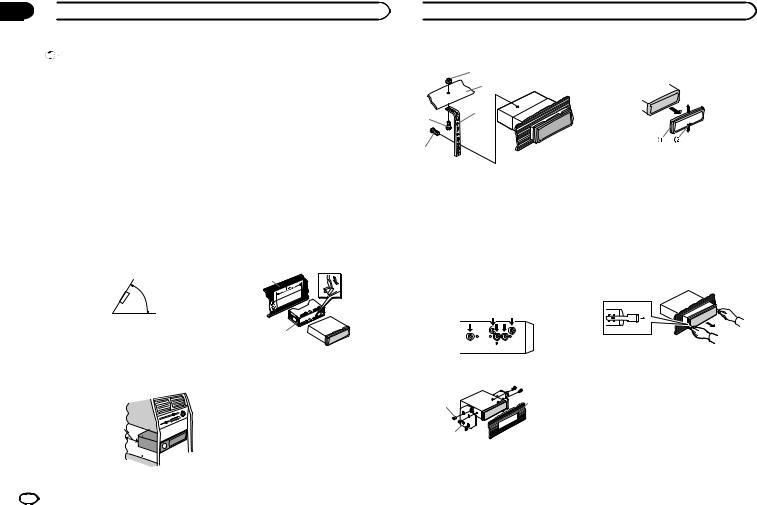
Sezione
01  Installazione
Installazione
Importante |
Montaggio DIN anteriore/ |
|
! Controllare tutti i collegamenti e i sistemi |
posteriore |
|
prima dell’installazione finale. |
Questa unità può essere installata correttamen- |
|
! Non utilizzare componenti non approvati, |
||
poiché potrebbero provocare malfunziona- |
te sia dalla posizione di montaggio anteriore, sia |
|
menti. |
dalla posizione di montaggio posteriore. |
|
! Consultare il rivenditore se l’installazione ri- |
Durante l’installazione utilizzare componenti di- |
|
chiede la trapanatura di fori o altre modifiche |
sponibili in commercio. |
|
del veicolo. |
Montaggio DIN anteriore |
|
! Non installare questa unità se: |
||
— potrebbe interferire con il funzionamento del |
1 Inserire la fascetta di montaggio nel cru- |
|
veicolo. |
||
scotto. |
||
— potrebbe procurare lesioni al passeggero in |
||
Se l’unità viene installata in uno spazio poco |
||
caso di arresto improvviso del veicolo. |
||
profondo, utilizzare la fascetta di montaggio for- |
||
! Se si surriscalda il laser a semiconduttore |
||
nita. Se dietro l’unità vi è spazio sufficiente, uti- |
||
potrebbe subire danni. Non installare questa |
||
lizzare la fascetta di montaggio fornita con il |
||
unità in luoghi soggetti a surriscaldamento, |
||
veicolo. |
||
come in prossimità delle bocchette dell’im- |
||
|
||
pianto di riscaldamento. |
2 Assicurare la fascetta di montaggio utiliz- |
|
! Le prestazioni ottimali si ottengono quando |
||
zando un cacciavite per piegare le linguette |
||
l’unità viene installata con un’angolazione in- |
||
metalliche (90°) in posizione. |
||
feriore a 60°. |
||
|
||
|
1 |
|
60° |
|
|
! Durante l’installazione, per assicurare la cor- |
2 |
|
retta dissipazione del calore quando si utiliz- |
|
|
za l’unità, accertarsi di lasciare ampio spazio |
|
|
dietro il pannello posteriore e avvolgere even- |
1 Cruscotto |
|
tuali cavi allentati in modo che non ostrui- |
2 Fascetta di montaggio |
|
scano le aperture. |
|
Lasciare ampio spazio
5 cm
5 cm
5cm
 Installazione
Installazione
3 Installare l’unità come illustrato.
1
2
3
4
5
1Dado
2Paratia antifuoco o supporto in metallo
3Staffa metallica
4Vite
5Vite (M4 × 8)
#Accertarsi che l’unità sia saldamente installata in posizione. Un’installazione instabile potrebbe causare salti audio o altri malfunzionamenti.
Rimozione dell’unità
1 Rimuovere la guarnizione.
1Guarnizione
2Linguetta intaccata
!La rimozione del frontalino permette di accedere facilmente alla guarnizione.
!Quando si riapplica la guarnizione, spingere il lato con la linguetta intaccata verso il basso.
2 Inserire le chiavi di estrazione fornite su entrambi i lati dell’unità fino a che non scattano in posizione.
Montaggio DIN posteriore
1 Determinare la posizione appropriata, in modo che i fori sulla staffa e sul lato dell’unità corrispondano.
2 Serrare due viti su ciascun lato.
1 |
3 |
|
2
1Vite autofilettante (5 mm × 8 mm)
2Staffa di montaggio
3Cruscotto o console
3 Estrarre l’unità dal cruscotto.
Rimozione e reinserimento del frontalino
È possibile rimuovere il frontalino per proteggere l’unità dai furti.
Premere il tasto di rimozione e spingere il frontalino verso l’alto tirandolo verso l’esterno.
Per ulteriori dettagli, vedere il manuale d’istruzioni.
10 It
